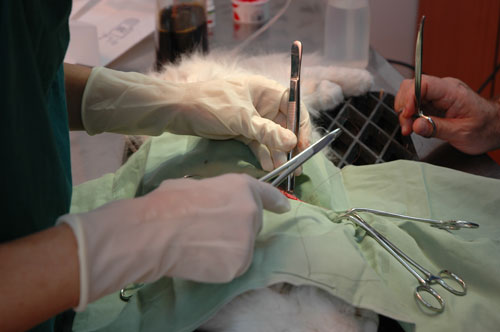
L’anesthésie générale entraîne une perte de conscience et de sensation au corps de l’animal. Le procédé d’induction de l’anesthésie générale comprend plusieurs étapes, commençant par l’administration d’une sédation, suivie d’une injection intraveineuse d’un agent anesthésique qui mène à l’état d’inconscience du patient. Ensuite, un tube de respiration est placé dans la trachée et un gaz anesthésique, en combinaison avec de l’oxygène, est respiré par l’animal via le tube respiratoire pour maintenir l’état d’inconscience.
Bien que ce type d’anesthésie soit plus sécuritaire que dans le passé, il existe toujours la possibilité d’une complication anesthésique. Nous recommandons un examen physique complet ainsi qu’un test sanguin afin de pouvoir bien évaluer l’état de santé de votre animal. Ceci va permettre d’identifier et d’évaluer le risque anesthésique. Un profil sanguin pré-anesthésique fournit de l’information importante sur l’état de santé des organes internes. Le fonctionnement des reins et du foie est particulièrement important puisque ces deux organes sont responsables du métabolisme des agents anesthésiques. Un problème avec la fonction d’un de ces organes peut avoir des effets néfastes sur la récupération anesthésique de votre animal.
A general anesthetic results in a loss of consciousness and sensation to the body. The general anesthetic procedure involves several steps beginning with the administration of a sedative, followed by an intravenous injection of an anesthetic which renders the animal unconscious. Then, a breathing tube is placed into the trachea. An anesthetic gas is then delivered in combination with oxygen to the animal via the breathing tube to maintain the state of unconsciousness.
Although general anesthetics are significantly safer than they have been in the past, there is still the remote chance of an anesthetic complication. We recommend a complete physical examination and a blood test prior to an anesthetic to help identify any potential risks. A preanesthetic blood test provides additional information on the health status of the internal organs of your animal. Of special importance are kidney and liver functions, since these two organs are responsible for the metabolism of the anesthetic. Malfunction of these organs can have deleterious effects on the anesthetic recovery of your animal.

